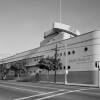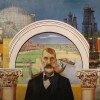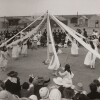California Dreaming: Booms and Busts of the Golden State

Union Bank is a proud sponsor of Lost LA. 
Dreams come big and dreams come small. But dreams — irrespective of their size and scope — drive human behavior. Dreams have launched the boom and bust cycle of California for hundreds of years, marked by Spanish dreams of gold bullion and coercive Christianization, Mexican dreams of northern expansion, and American dreams of mineral wealth and manifest destiny, to name only a few. Though Northern California developed earlier, the southern portion of the state soon followed a similar course. California history, much like that of America’s, rests on the noblest of deeds, the most nefarious of acts and a sea of grey in between, all driven by the very dreams that fuel boom and bust cycles.
Though Americans began trickling into Alta California decades prior to the Gold Rush, the 1849 bonanza put the new American territory on the proverbial map. Miners from all over the U.S., China, and Latin America descended on Northern California, all in search of gold veins guaranteeing riches beyond their wildest imaginations. Most found their aspirations unfulfilled. Plenty died. “It is an everyday occurrence,” wrote Garret Low of Nevada City in 1851, “to see a coffin carried on the shoulders of two men, who are the only mourners and only witnesses to the burial of some stranger whose name they do not know.”[1] Soon companies and corporate American interests cornered the gold market, yet the new arrivals populated the northern part of the state quickly.

Beyond mining the Mother Lode, San Franciscans found other ways to profit, through the hotels, restaurants, and the bawdy, sexual entertainments and corporeal pleasures of the city’s Barbary Coast. Filled with steak and drink, Jack London unleashed “his most savage instincts” on the city, often visiting houses of ill repute. “What more, after being well fed, may a man want?” London asked. “There is a mastery in it. A feeling of power, a satisfaction of the instinct that inclines us toward beauty.”[2]
Eventually, Northern California’s population bulge shifted south. “Los Angeles has always been a boom town, chronically unable to consolidate its gains or to integrate its new population,” wrote one of the state’s great chroniclers, Carey McWilliams.[3] Southern California’s pastoral beauty was soon transformed, as land speculation took hold. By the late 1800s, Los Angeles “first and above all the creature of real estate capitalism … subdivided and sold” by generations of boosters, began to match the development of its northern counterpart.[4]
In the context of an industrializing nation, visions of wealth derived from denuding the landscape of mountains and forests or spurious land development imbued real value to the natural world. Upon his first visit to Yosemite, John Muir wrote in his journal “Born Again!” Though established as a national park in 1864, Yosemite would not have lodged itself into the popular imagination without the efforts of Muir, Gifford Pinchot, and perhaps most importantly, Theodore Roosevelt.
For naturalists, California offered pristine landscapes filled with unique flora and fauna, but only so long as its majestic terrain remained untouched. As Civil Service Commissioner in the 1890s, Roosevelt used his power to cajole the Secretary of Interior Hoke Smith to better care for California’s, and the nation’s, natural wonders. “It will be an outrage if this government does not keep the big Sequoia Park, the Yosemite, and such like places under touch,” he implored.[5]
As president, he went further through law, statesmanship, and experience. In 1903, Muir led Roosevelt on a three-day excursion in the park, including Mariposa Grove, Sentinel Dome, Glacier Point, and the Yosemite Valley. “There can be nothing in the world more beautiful than the Yosemite, the groves of giant sequoias and redwoods, the Canyon of the Colorado, the Canyon in the Yellowstone, the Three Tetons,” the president later noted. “[O]ur people should see to it that they are preserved for their children and their children’s children forever with their majestic beauty unmarred.”[6] Roosevelt’s California experiences were transformed into national policy as he expanded the nation’s national park system to an unprecedented size.
Even the sparser desert landscapes that cover swaths of the state have served as inspiration. On the cusp of establishing themselves as one of the most popular bands of the 20th century, the Eagles ate peyote and traveled to Joshua Tree for a photo shoot that resulted in the cover of the band’s first album. Riches and notoriety followed. Their bust came decades later; though undoubtedly popular, the Eagles became critically reviled, as summarized by one of California’s most famous fictional residents, Jeffrey Lebowski: “Man, come on. I had a rough night and I hate the [expletive] Eagles, man.”

More political endeavors than popular music drew socialists and others to the utopian Mojave Desert community of Llano del Rio (1914-1918). Nearly a hundred miles of unpaved road separated Llano residents from downtown L.A. One could argue an even greater distance existed between their dream community and the California reality. The commune ultimately failed, but as cantankerous L.A. historian Mike Davis reminded us in the late-20th century, its ghost town functioned as a harbinger of things to come, declaring “The best place to view Los Angeles of the next millennium is from the ruins of its alternative future.” Indeed, Llano serves as an antecedent of the Occupy movement that briefly rose to prominence after 2008, with one of its most iconic settlements in Oakland.[7] In both cases, egalitarianism and economic justice were the goals being chased, which were very different dreams than those motivating the Gold Rush-era miners or turn-of-the-century naturalists.
Two world wars with the Great Depression sandwiched in between drew new investors and residents. Newcomers from Latin America, Asia, Europe, and the American Midwest flocked to California, all hoping to break off a piece of the burgeoning west coast lifestyle. After World War I, Hollywood consolidated its place in international moviemaking — constructing and selling dreams to audiences worldwide. Real estate agents speculated, and advertisers promoted. By the 1930s, Southern California’s economic boom, derived from middle-class savings spent on real estate and oil speculation, “ensured a vicious circle of crisis and bankruptcy” for Angelenos, and the Great Depression helped to usher in the brutal bust.
Paradoxically, amid the massive economic downturn, Southern California actually increased its manufacturing holdings as tire and car producers established footholds in Metro L.A. However, World War II brought unimaginable windfalls to San Francisco, San Diego, and Los Angeles, as soldiers and military infrastructure embedded itself in the land.[8]
In the glow of post-World War II prosperity, California’s natural coastal beauty took center stage. Visions of beach lifestyles ranging from bongo-playing beatniks, rebellious surfers, and the sophisticated inhabitants of modernist beachfront homes came to define California. Movies like the 1966 classic, “The Endless Summer” and “Gidget”, musical groups like the Mamas and the Papas, Fleetwood Mac, and the Beach Boys, all helped to define the booming post-1945 west, and encapsulated the kind of postwar optimism and economic growth that engulfed America. California served as the metronome of an increasing aspirational American society.
Yet even amidst such optimism, cultural unease lurked. Frederick Kohner, author of the “Gidget” book series that later became a film and television show, had fled Nazi Europe in the late-1930s, part of a wave of German and Austrian emigres such as Bertolt Brecht and Billy Wilder who settled in Los Angeles, mixing Weimer Republic aesthetics with the literary noir of Raymond Chandler and James M. Cain. Not quite “Born again!” as exclaimed by Muir upon encountering Yosemite, but a chance at personal and professional renewal. For Kohner, it meant economic success. For others, the California dream failed to live up to the nostalgic memory of Europe as it had been before World War II. For example, Brecht endured seven years in the City of Angels before returning to Europe. He expressed his views regarding the Southern California metropolis clearly in his poetry: “on thinking about Hell, that it must be/Still more like Los Angeles.”[9]
Even if unhappy, however, Wilder and others brought European sensibilities to American film, expressed most vividly in noir, a genre that raised heightened awareness of the demographic and cultural changes brought by the war. Noir was “a fantastic convergence of American ‘tough-guy’ realism, Weimar expressionism, and existentialized Marxism,” writes Davis.[10]
Women and minorities, having long-fought for equal standing in society, and who would continue to demand the same as others in the nation, promoted democracy abroad. Homeownership spread, and the country enjoyed economic advantages that led to industrial growth. As great as noir films might be, they depict the costs of modern urbanity — cities with homosexuals, communists, independent women, and minorities to be specific — as the nation turned to suburban existence. Through books and film, Los Angeles noir reimagined the city as a “deracinated urban hell,” with apocryphal suburban dreams as the antidote to a racist urban nightmare.[11]
Other immigrants to California had sought to recreate European existences before the arrival of German and Austrian emigres. In the late-1800s, visitors to California depicted its urbanity much as they might a Southern European city. Real estate developer and speculator Abbot Kinney agreed. He constructed the canals of Venice based on its Italian namesake, even importing gondoliers. Eventually, the canals were drained and the gondoliers faded away. During the 1970s, however, Venice, along with the dystopian remnants of Pacific Ocean Park in Santa Monica, would serve as midwife to modern skateboarding. The working class, multi-racial youth of the Zephyr team defined the rudiments of the skateboarding through the built environment. By the end of 20th century, skateboarding had become a multi-billion dollar industry.
Pacific Ocean Park’s demise paralleled the rising cultural dominance of America’s most famous theme park, Disneyland. Few channeled Cold War American sensibilities like Walt Disney. If noir represented the collective societal anxiety of Americans, Disneyland served as the manifestation of their suburban dreams. Disney took a noirish view of the United States. He found amusement parks, notably New York’s Coney Island, with its unsupervised couples along with the city’s teeming immigrant masses all mixing along the shore, a threat to the larger society. Too disordered, too diverse.

Theme parks in California, like those in New York, predated Disneyland by decades. The verdant landscapes of San Gabriel Valley prior to the Whittier Narrows Flood Control project served as the setting for “Tarzan” films and the movies of D. W. Griffith. Disney aggregated this tradition by adopting the methods of film and the role of thematic setting while filtering it through his beliefs. Disneyland “renounced the contradictions and uncertainties of modern urban society,” notes historian Eric Avila. Instead, through the park, Disney sought to “create a counterculture of order, regimentation, and homogeneity” that organized a wealthy society on the edge of cultural upheaval as the civil rights movements of the 1950s, ‘60s, and ‘70s challenged established hierarchies.[12]
In terms of design, the park influenced architects, designers and urban planners across the U.S. “Success inside Disneyland’s walls encouraged imitation outside,” notes historian John Findley. Across the nation, Disneyland cast a “powerful influence on urban form.”[13] With the Whittier Narrows Flood Control project completed in the 1950s, the very suburbanization, which Disneyland epitomized, unfolded. Suburbia’s boom occurred adjacent to the expansion of the Disney Empire and shaped daily lives in the most prosaic and profound ways. Even Avila, who once wrote that Disneyland cultivated “racialized conservatism” acknowledges that it remains the standard by which amusement parks are measured and continues to serve as a fantasy archetype for children and adults regardless of race, gender, or sexuality.[14]
Despite its increasing national influence, mid-century California remained, as Joan Didion once wrote, “hermetic … isolated by geography and by history and also by inclination.” By the 1970s, the famed writer came to a realization about the state and its past: “in the South they remained convinced that they had bloodied their land with history. In California, we did not believe that history could bloody the land, or even touch it.”[15] Yet, California’s history was shaped by, and also shaped the nation’s conception of itself. People, money, and infrastructure poured in while California’s culture flowed outward. Booms and busts, and dreams and nightmares alike all filtered through the Golden State.
Top Image: Ocean Park Beach in Santa Monica crowded with bathers, ca.1910 | USC Digital Library; from the California Historical Society Collection at the University of Southern California
[1] Kevin Starr, Americans and the California Dream, 1850-1915 (New York: Oxford University Press, 1973), 55.
[2] Starr, Americans and the California Dream, 236.
[3] Carey McWilliams, Southern California: An Island on the Land (Salt Lake City: Gibbs Smith, 1973), 114.
[4] Mike Davis, City of Quartz: Excavating the Future in Los Angeles (New York: Verso, 2006), 25, 37.
[5] Douglas Brinkley, The Wilderness Warrior: Theodore Roosevelt and the Crusade for America (New York: Harper, 2009), 267
[6] Brinkley, The Wilderness Warrior, 20-21.
[7] Davis, City of Quartz, 3-4.
[8] Roger Lotchin, Fortress California, 1910-1961: From Warfare to Welfare (Champaign-Urbana, IL: University of Illinois Press, 1992).
[9] Davis, City of Quartz, 51.
[10] Davis, City of Quartz, 18.
[11] Davis, City of Quartz, 37.
[12] Eric Avila, Popular Culture in the Age of White Flight: Fear and Fantasy in Suburban Los Angeles (Los Angeles: University of California Press, 2004), 119, 137.
[13] John Findlay, Magic Lands: Western Cityscapes and American Culture After 1940 (Los Angeles: University of California Press, 1992), 3.
[14] Avila, Popular Culture in the Age of White Flight, 143.
[15] Joan Didion, Where I Was From (New York: Vintage International, 2003), 64, 71.


























